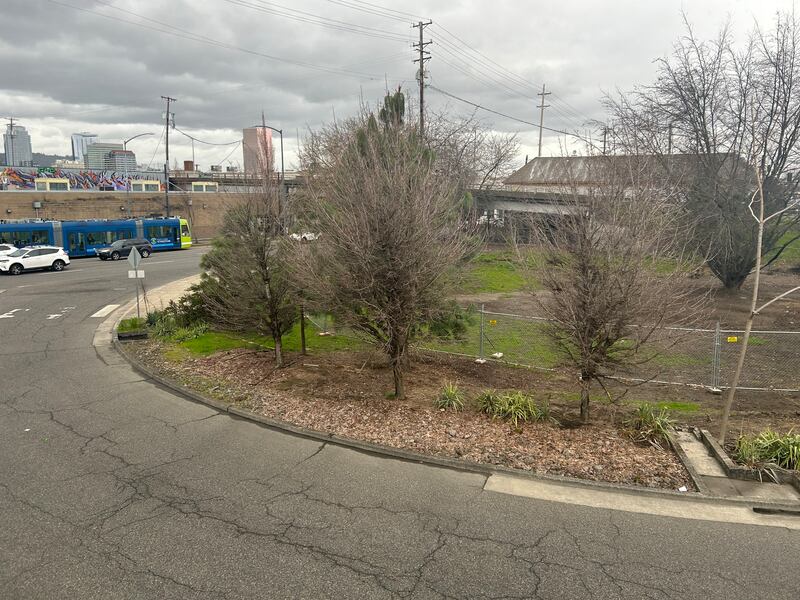For two years, city of Portland contractors paid homeless campers $20 an hour to maintain the landscaping surrounding their tents at a trio of grassy gullies in the Central Eastside.
It’s not clear city officials fully realized what they were funding. But the reality was that the “stewards” lived amid the landscaping they were paid to maintain, inside the cloverleaf ramps of the Hawthorne and Morrison bridges.
For a while, the city hailed the program as a success. The campers got a semi-permanent home with a small salary, and the gentrifying industrial neighborhood got badly needed greenspace. The city was so impressed it presented the local business association with an annual award for facilitating it.
Then, with little warning, it all fell apart. The program’s contract was canceled last month and the city surrounded the three blocks with a locked chain-link fence.
The once-lauded program was certainly facing challenges.
The campers’ presence may have proved more harmful than helpful. The bioswales where they lived and worked were small greenspaces designed to filter contaminants from floodwaters before they entered the river system. But the campers’ very presence undermined that goal.
Large portions of the bioswales turned into mud pits, and fires were frequent. One such blaze destroyed a prized tree. Another killed a litter of puppies.
Meanwhile, the bioswales were swept up in the larger debate over the city’s treatment of its homeless residents. In January, City Hall began cracking down on the most visible camps that Central Eastside businesses were reporting as nuisances, including those that housed the stewards the city was paying an hourly wage.
Barbra Weber, the project’s manager, says she has mixed feelings about its collapse. On one hand, as an ardent environmentalist, she’s happy the ecosystem can heal after withstanding so many years of boots and tents.
On the other, she’s watched the community she’s nurtured be uprooted and destroyed. “I was devastated,” she says. “I feel like I failed.”

The city announced the bioswale restoration program on April 29, 2021, with a two-day tree planting event, attended by newly elected City Commissioner Mingus Mapps. “This tree planting and the long-term program behind it brings people together to create lasting relationships, lasting opportunity, and lasting stewardship,” he said at the time.
A photo distributed with the press release shows Mapps in jeans, a yellow safety vest and a baseball cap, flanked by volunteers happily planting trees in one of the program’s three bioswales. (A bioswale is an urban planning term for a vegetated channel designed to filter pollutants from groundwater.)
After the trees were planted, Weber recruited weekly maintenance crews from the dozens of tents that dotted the bioswales. On Fridays, she rewarded their labor with cash. City officials deny being aware that stewards were living on the site. “We did not monitor where the stewards lived,” a Bureau of Environmental Services spokesperson tells WW.
For a while, it was a success, she says. Longtime hoarders learned to pick up after themselves to protect the fragile grass. And reliable wages gave them hope they could eventually get off the streets.
The city wrote the program into its contract with Central Eastside Together, one of the city’s three enhanced service districts that fund security and cleanup services through fees levied on local businesses and property owners. It then subcontracted the maintenance work out to a local nonprofit called Trash for Peace, which distributed cash to stewards. (Central Eastside Together is managed by the district’s business association, the Central Eastside Industrial Council.)
The program ultimately cost the city around $25,000, according to estimates provided to WW by the city’s Bureau of Environmental Services.
Two years in a row, the Portland City Council declared the business association a “most valuable partner” for its “partnership with the houseless community.”
But that “long-term program” was really just a two-year pilot. And it didn’t make it even that long, falling victim to a political reset at City Hall, pressure from neighborhood businesses, and high-profile fiascoes in the bioswales.
Late last year, Central Eastside businesses, including Salt & Straw, pleaded with Mayor Ted Wheeler to intervene in camping conditions and threatened to leave the city if he didn’t. “People don’t come to shop,” CEIC executive director Clare Briglio tells WW. “People don’t feel safe walking to work.”
One of them, Emre Taskin, owns a nearby shop selling Turkish rugs that has been repeatedly burglarized and vandalized. The city’s utopian ideals have backfired, Taskin says, citing the camps that ringed his business and the trash that piled up in the bioswales.
Taskin moved here from Istanbul in 2013 and now plans to leave for New York once his lease expires. “It’s a bad experiment,” he says. “We’re fed up.”
Spurred on, Mayor Wheeler sprang into action, launching a “90-day reset,” modeled on last year’s similar effort in Old Town. By February, the number of mass encampments had dropped from 150 to less than 90, Briglio says.
Soon, the camps in the bioswales were swept away too. They were a safety hazard, Briglio explains. In one, firefighters had to come out 39 times, according to city data shared with WW. Police were an even more frequent presence.
Then, on Valentine’s Day morning, a fire in the bioswales had citywide repercussions.
An encampment burned to the ground, killing six puppies and their mother. Weber traced the blaze back to a donated cabin with insulation that was improperly fireproofed.
The incident grabbed the attention of Portland’s new fire commissioner, Rene Gonzalez. That day, he directed bureaus under his control to stop handing out tents, citing the seven killed dogs in his press release.
Shortly thereafter, Weber was informed that the city was shutting down her program. She was stunned and blamed the fire. She had just entered negotiations with the city to expand the program from once-a-week to daily cleanups, which she felt would minimize the ecological damage caused by the camps. She dreamed of one day paying stewards to give public tours of the bioswales. Instead, on March 23, the city fenced them off.
“The mayor’s office appreciated that this program, at this specific location, was not working and needed to end,” Eric Zimmerman, Wheeler’s central city policy adviser, said in a statement. “We were very supportive when the Central Eastside Together group and the Bureau of Environmental Services quickly agreed to end the relationship. Those sites were in dire need of clean up and safety improvements. Anyone who drove by in the last year knows that.”
In a separate statement, Commissioner Mapps said: “We tried something new here, and all involved tried to create solutions for unhoused people, for infrastructure that we all depend on, and for environmental stewardship. These sites didn’t work as intended and became a safety issue, so we are ending that part of the contract. We are returning the bioswales to their original intention and natural function.”
Weber is heartbroken. Back in 2015, she lived in the bioswales herself. She saw parallels in her efforts to help both their ecology and the people that called them home. Now, she’s lost track of many of the people who once lived there. “These people are completely forgotten about. They fall off into no man’s land,” Weber says.
WW tracked down one of them. Tom was living several blocks west on vacant Oregon Department of Transportation property under the Morrison Bridge. He declined to give his last name, saying he’s been homeless for eight years while dodging an out-of-state arrest warrant.
Tom remembered the bioswale fondly: “I thought it was a place I could stay awhile.”

